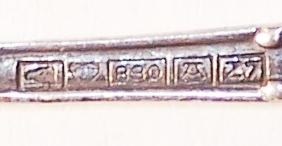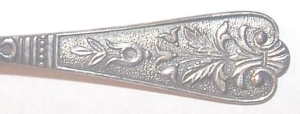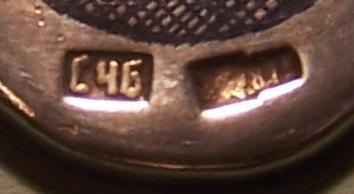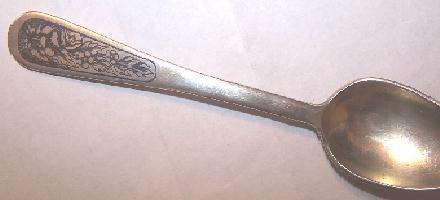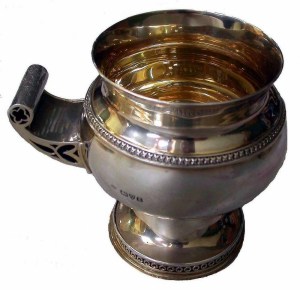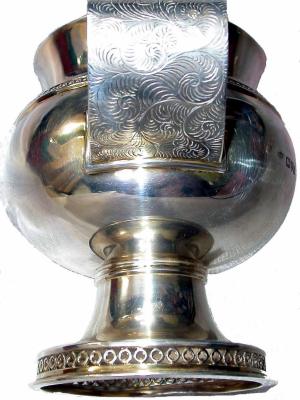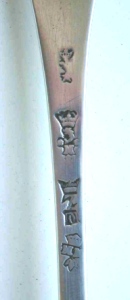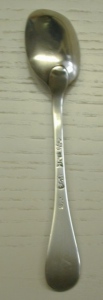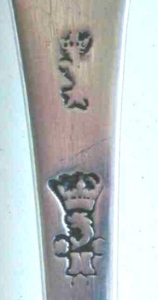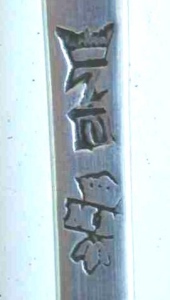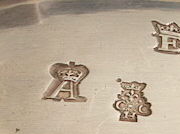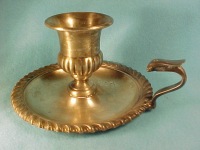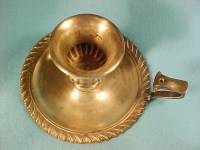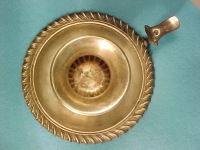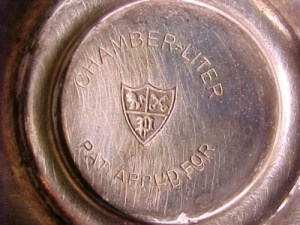|
ASCAS MEMBERSHIP
Members who have not yet sent their confirmation are
invited to renew their membership to ASCAS by replying to this
e-mail (just use the 'reply' function to this email).
Shipping of ASCAS Nerwsletter to non-confirmed members will be
suspended next month.
My thanks for many confirmations, encouragements and offers of
collaboration I've received by members. I hope that June will be
the last Newsletter with an excess of Giorgio Busetto's articles.
Thanks for your attention.
Giorgio Busetto
ASCAS Secretary
A new article for ASCAS website
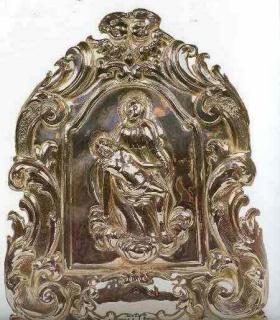 Giorgio Guida and Giorgio Busetto present
Giorgio Guida and Giorgio Busetto present
'An ancient liturgical object: the PAX' - 'Un
antico oggetto liturgico: la 'Pace'.
An ancient object used in liturgical ceremonies.
This article is available in double version
English
 -
Italiano
-
Italiano
 |
List of members
Welcome to new ASCAS members:
Viviana Alonso Muso - Argentina
Paul Blitzblau - USA
Ronald H. Boyce - Canada
Suzanne De Vall - USA
Owen Dobson - England UK
Terry Haines - England UK
Mary Hopper - USA
Hugo Keymeulen - Belgium
Margaret Lewis - USA
Lauri McCormick - USA
Anna Miles - USA
Cecilia Moguilansky - Argentina
Bernard Molloy - England UK
Audrey Pilling - USA
Sandra Pollero - USA
Leslie Salvage - England UK
Kim EW Shell - USA
Susan D. Sinclair - USA
Hester Valckenier Kips - the Netherlands
Members' Window # 14
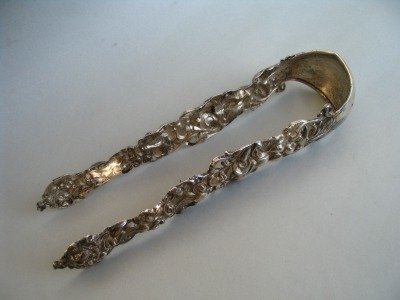 Giorgio Busetto presents:
Giorgio Busetto presents:
CARL ADOLF KOHL: silversmith and ... cartoonist
unusual resemblances on Austrian sugar tongs of 19th
century.
click here |
Questions from ASCAS members
Jayne Dye writes:
Giorgio, and readers,
question #1: Maybe you would be so kind as to consider
publishing this spoon. We bought it 1n 1996 in a very tiny
'junk' store in a little alley in Helsinki, Finland from the the
shop's Russian owner.
reply #1: your spoon was made in Finland and hallmarks
correspond (from left to right):
silversmith (I'm unable to attribute) - National mark - purity
degree (in thousands) - town mark (Turku) - year (1964)
question #2: This second spoon was also purchased in the
little shop in the little alley in Helsinki, Finland from the
same Russian shop owner. Some of the marks are the same. Some
are very difficult to see clearly. The spoons are quite
different in style and design.
reply #2: hallmarks are similar to #1- The only difference
is the 'date letter' Z7 corresponding to 1977
Question #3: We bought four spoons the same day and here is
the third one. It is Supposed to be Russian also. If one of them
is Finish, Norwegian or Swedish that would be fine with us. None
of the marks look Finish or Swedish to me. This one has a design
technique which I do not have a name for. Black etching pattern.
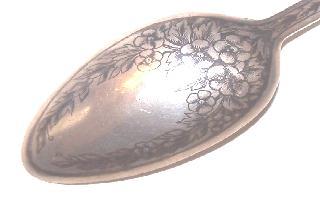
|
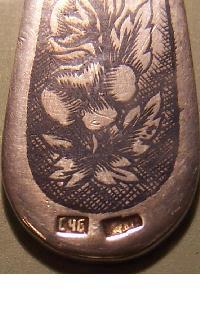
|
reply #3: this is a Russian spoon, but it is a silver
piece from Soviet Russia and not from Tsarist Russia.
The mark on the left, representing two cyrillic letters (S and
CH) and number 6, is the mark of VelikoOustiuskaia Fabrika (presumably
Veliki Ustiug town's Factory) Severiaia Chernb
The mark on the right is a male head and 875 (875 per thousand,
as Soviet Russia left the use of zolotnik for silver purity
degree). This mark was in use (between 1927 and 1958).
The decoration of the spoon is on 'niello' (from latin
nigellum), a tecnique which consists in filling silver
engraving with a special amalgam of silver, lead, copper and
sulphur, obtaining decoration of different shades depending on
sulphur percentage.
Niello is a typical decoration of Russian silver.
You may see another Russian nielloed spoon of unusual shape on
my private website at
http://www.silvercollection.it/pagina59.html
Giorgio Busetto
Hymie Dinerstein writes:
I need some help on this piece.
Size from handle to handle is 11"
The silver oval dish is 4 3/4" long, 3 1/2" wude and stands
approxiametly 2 1/4" tall and the only mark underneath is
"PONCE"?.
Any one any ideas- Spanish, Portuguese, Italian?
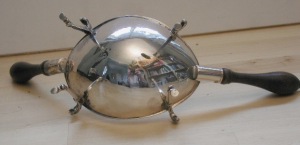
|
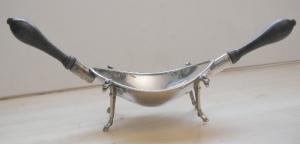
|
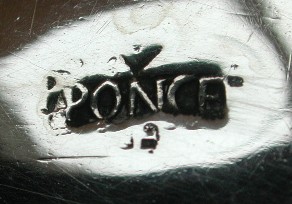
|
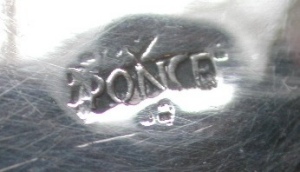
|
Your item is a brasero (chofeta, ember bowl) made in Spain by
silversmith Ponce Manuel (town: Palencia, province:
Castilla-Leon, year: 1779). For more information and images
about ember bowls you may see my private website at
http://www.silvercollection.it/pagina22.html
http://www.silvercollection.it/pagina188.html
http://www.silvercollection.it/pagina191.html
Giorgio Busetto
Mark Mandel writes:
hello Giorgio, I wrote in response to issue #13, and included
a question about a german 800 silver pastry server.
My question was if it would be alright to post the question
without having a picture, as I do not have access to a digital
camera. I can date the object between 1888 and 1920 approx
because of the crescent moon and crown.
I can describe the piece which is pierced and cast and has a
curious mixture of neoclassical and romantic elements. The
maker's mark is a six sided star of david with a Z inside. What
is his name, and what other info can i learn about him?
I await your reply. Thank you.
Mark Mandel
I'd be curious to see your pastry server and this mixture of
neoclassical and romantic elements.
Unfortunately I don't know the 'star of david and Z' mark but I
hope that ASCAS members will reply to your question (a similar
mark, but with G inside, belongs to Jakob Grimminger:
www.silvercollection.it.
Giorgio Busetto
What is this piece ???
Fred Sinfield writes:
A Mystery Cup.
Does any one recognise this cup?
Standing 115mm tall, the bowl is 85mm wide and its weight is
just under 300grams.
The inside of the bowl is gilded and rather unexpectedly so is
the inside of the base.
There are gilded highlights on the “XXXX” around the shoulder
and the trefoils on the base.
An unusual feature is the single curved 40mm wide grip with
trefoil and fern-like engraving.
The maker’s mark is SB&S LTD, the Birmingham based S.
Blanckensee & Son Ltd.who had this item assayed in Chester in
1927-28.
The cup appears to be either a reproduction of a piece from
antiquity or made for some special event, so any clues will be
appreciated
Replies to members' questions
The spoon of Christine and Denis Mercier on May Newsletter
has received three replies by our members:
Maurizio Perota writes:
description of spoon's hallmarks of the spoon of Christine
and Denis Mercier from top to bottom
1: unreadable - presumably it's a 'decharge' hallmark
2: 'Jurande' of Grenoble from 1708 to 1712
3: 'charge' of Grenoble from 1700 to 1715
4: silversmith Michel Millerand père, member of the guild of
Grenoble about 1695 - dead 1751
Maurizio
---
Olivier Moulines writes:
This spoon was made in Grenoble (France) between 1709 and
1715 by silversmith Michel Millerand (1671-1751).
The hallmarks are described in the book of Mrs Godefroy, “Les
orfèvres du Dauphiné” – Librairie DROZ – Genève.
The spoon bears:
the 'charge' hallmark (Z and 2 D interwoven)
the 'décharge' (a crowned fleur-de-lis and a star) of Grenoble's
'fermier de la marque' des Vaux des Ayberts,
the 'jurande' of Grenoble (a dolphin and letter 'M') in use
between 1709 and 1715
the silversmith's mark of Michel Millerand (crowned letters MM
over an Acanthus leaf).
Michel Millerand was an important Grenoble silversmith and
worked for high level customers.
I'd add that this spoon may not be a Royal gift as the King was
exempted from paying the duty mark and, moreover, he used Paris
silversmiths for his orders. On the contrary it's possible that
this spoon was use by the nursemaid of the Royal children, born
in 1710.
Was this spoon used by Louis XV? It is possible. Who knows?
(texte français)
Cette cuillère porte les poinçons de charge (Z et 2 D
entrelacés) et de décharge (une fleur de lis couronnée et une
étoile) du fermier de la marque pour Grenoble : des Vaux des
Auberts, le poinçon de jurande de Grenoble (un dauphin et la
lettre M) utilisé entre 1709 et 1715, et le poinçon de maître
orfèvre de Michel Millerand (lettres MM couronnées surmontant
une feuille d’acanthe).
Michel Millerand était un orfèvre important de Grenoble et a
travaillé pour une clientèle de condition.
Je voudrais ajouter qu’il ne peut s’agir d’un cadeau royal
puisque la Couronne ne payait pas les droits de marque et qu’elle
commandait à cette époque à des orfèvres parisiens. Il est par
contre possible que cette cuillère ait été utilisée par la
nourrice de l’enfant royal, né comme chacun le sait en 1710.
A-t-elle servi à Louis XV ? C’est possible. Chi lo sa ?
Olivier Moulines
---
Pierre Debaillie writes:
Here is the reply to Mercier's question.
The first mark (faint) is the 'decharge' mark
The second is the 'Maison Commune' mark of Grenoble 1708/1712
The third is the 'Poinçon de charge' of 'Juridiction de
Grenoble' 1700/1715
The fourth is the mark of silversmith Michel MILLERAND père,
born about 1695, dead in 1751 Reference book: Dictionnaire des
poinçons des Provinces Françaises, Jacques HELFT- F de NOLELE
édit.1968 Paris. Best regards.
Pierre
(texte français)
Voici la réponse à la demande de Mercier.
Le premier poinçon de gauche est un poinçon de décharge ( peu
lisible)
Le second est le poinçon est la Maison Commune de Grenoble
1708/1712
Le troisiemme est le poinçon de charge de la Juridiction de
Grenoble 1700/1715
Le quatriemme est le poinçon de l'orfèvre Michel MILLERAND père,
reçu vers 1695, décédé en 1751.
Référence: Dictionnaire des poinçons des Provinces Françaises,
Jacques HELFT- F de NOLELE édit.1968 Paris.
Amitiés
Pierre
---
Further informations about the hallmarks of Ann Schrad's gravy
boat
(April Newsletter)
Andrea Perego writes:
the gravy boat was made in Paris in 1745 (date letter 'E' and
'charge' mark 'A' used between 1745 and 1749).
Silversmith Charles Cèsar Haudry - Paris (his hallmark was
registered on July 28, 1732.
The gravy boat is lacking the 'decharge' mark (greyhound running
toward right).
---
Fredric Sinfield writes:
....The maker of Ann Schrad's piece appears to be Charles
Cesar Haudry of Paris who registered in 1732....
---
A reply to Kavin & Cynthia Johnson for their candlestick holder
(April Newsletter)
Karin Sixl-Daniell writes:
Kavin & Cynthia Johnson asked for some information on their
candle stick in the newsletter: It is made by Prill Silver Co.
in New York (who took over Edward Prill Inc. in 1940).
---
Some replies to Maurizio Perota's 'What is this item? on May
Newsletter
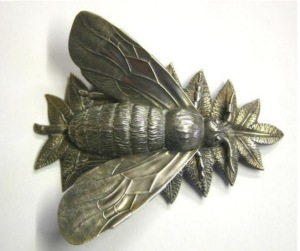 |
E. Jones writes:
Reference the enquiry from Maurizio Perota regarding the
delightful bee, firstly, I would assume it is either a container
for pins and came from a sewing work-basket as in 'Busy Bee', or
a paper-weight designed to hold paper clips.
Either way, it looks as if the clips may have held another layer
in place, maybe papers of sewing needles, or pen nibs?
As there is an English patent mark, why not check out the patent
on the web and find out about this item's registration?
I am curious to know the answer so please pursue it.
---
Brian Ransom writes:
The bee shaped case, in addition to the other two boxes by W.
Avery & Son, is most likely the sewing accessory, a 'needle
case'.
Regards,
Brian Ransom
---
ASCAS member Giovanni Ciceri has enriched his website with the
English version of the pages devoted to English silver hallmarks
(British hall-marks system, main assay offices, Provincial assay
offices, etc.)
The web address of the new English section is
http://www.argentinglesi.com/indexing.html
Giovanni Ciceri is the author of the article TEN STEPS TO VERIFY
THE AUTHENTICITY OF ANTIQUE SILVERWARES, published on April 2005
Newsletter.
Closing our June newsletter I hope you have appreciated its
content.
Your comments, suggestions and advice will be of great help.
My thanks to Giovanni Ciceri, Pierre Debaillie, Hymie Dinerstein,
Jayne Dye, Giorgio Guida, E. Jones, Mark Mandel, Olivier
Moulines, Andrea Perego, Brian Ransom, Fredric Sinfield and
Karin Sixl-Daniell for their precious contributions.
Giorgio Busetto
Secretary
|
 newsletter # 14 JUNE 2005
newsletter # 14 JUNE 2005




